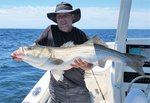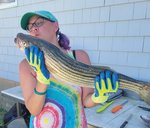

South Fork Wind, a joint venture offshore wind project developed by Ørsted and Eversource, announced earlier this month it has signed an agreement with environmental organizations to further enhance measures designed to protect the North Atlantic right whale during construction and operation of the offshore wind farm.
The agreement with the National Wildlife Federation (NWF), Natural Resources Defense Council (NRDC), and Conservation Law Foundation (CLF) expands on the commitment from Ørsted, the leading U.S. offshore wind energy partner, and Eversource, New England’s largest energy provider and experts in regional energy transmission, to responsibly build clean energy projects while minimizing and mitigating impacts to marine wildlife and critical habitat.
North Atlantic right whales are one of the most endangered whales on the planet and scientists estimate that fewer than 340 remain. South Fork Wind has committed to measures that will help protect these whales in the project area, where their habitat is increasingly threatened by climate change. For example, South Fork Wind will adopt monitoring measures to help ensure right whales are not in close proximity to the construction site during construction activities, implement mitigation to reduce noise during piling, and evaluate other new monitoring technologies as part of the agreement.
To guard against vessel strikes, the agreement also includes a 10-knot speed limit for all project-related vessels unless an effective adaptive speed management plan is in place. South Fork Wind will test advanced technologies that detect and have the potential to track whales, including thermal cameras, acoustic sensors, and data integration software..
The NWF, NRDC, and CLF are working to advance offshore wind energy as a key resource to combat climate change, aiming to establish the industry in a way that includes protections for vulnerable marine life and habitat. The groups are working across sectors to address impacts to critically endangered North Atlantic right whales, which face serious threats from entanglement in fishing gear and vessel collisions, and shifting prey and habitat availability due to climate change.
Giant Atlantic bluefin tuna angling category closure
Fishermen aboard Atlantic Highly Migratory Species (HMS) Angling or HMS Charter/Headboat permitted vessels (while fishing recreationally) may not retain, possess, or land large medium or giant Atlantic bluefin tuna measuring 73 inches curved fork length or greater in the northern area effective June 29, 2022, through December 31, 2022.
Based on the best available landings information, the 1.8-mt Angling category northern area “trophy” bluefin tuna (measuring 73 inches or greater) sub quota has been reached and exceeded.
Note that the Angling category fishery for school, large school, or small medium bluefin tuna (27 to <73 inches) remains open.
Smooth puffer fish can be deadly
The Department of Environmental Management (DEM) Division of Marine Fisheries and the Rhode Island Saltwater Anglers Association (RISAA) are warning of increased reports of anglers catching Smooth Puffers Fish. Puffers belong to the family Tetradontidae, which is comprised of around 120 known species. Smooth Puffers have a fairly significant range in the western Atlantic Ocean from New England and Bermuda to Argentina, though it’s more common in southern waters.
This member of the puffer family is a serious threat to your health if not cleaned properly. The neurotoxins in puffers responsible for illness and death are Tetrodotoxin and Saxitoxin, which adversely affect the human central nervous system. According to the US Food and Drug Administration (FDA), these toxins are deadlier than cyanide and there are no known antidotes for these toxins. Also, these toxins cannot be frozen or cooked out. Toxins can be found in all organs of the Smooth Puffer, intestines, and even in the skin.
Do not use Smooth Puffers for bait or chum. If you catch a Smoother Puffer, take this fish off the hook carefully and release it.
Where’s the bite?
Striped bass and bluefish. Neil Hayes of Quaker Lane Bait & Tackle, North Kingstown, said, “The striped bass bite continues to be strong out in front of Newport and at Block Island.”
Angler Allan Peters and his brother Tom, both of Warwick, fished the Southwest Ledge area of Block Island with eels. Allan said, “No fish until the fleet cleared out around 12:00 p.m. last Thursday, then it heated up. We caught ten stripers, two blues, two sea bass, and one dogfish. Katie Spier caught her first keeper striped bass Friday, a 48-inch fish caught trolling tube and worm off the Sakonnet River fishing with her uncle Greg Spier.
East End Eddie Doherty, said, “(Cape Cod) Canal Rats have become distressed at the news that there have been consistent catches of 30 & 40 pound striped bass in so many other venues, but not the Canal… Steve Ferreira was the only fisherman to catch a fish at the Falmouth Fishermen’s Association & Buzzards Bay Anglers Club annual cookout at Aptucxet.” “Fishing remains very good for striped bass with lots of schoolie to slot sized fish in the salt ponds and breachways, much larger fish out at Block Island. Live eels remain the top producer for large bass, but they can also be caught trolling or casting lures.” said Declan O’Donnell of Misquamicut Bait & Tackle, Charlestown.
Summer flounder (fluke) fishing is improving but remains spotty. Anglers are limiting out with smaller fish in the 18-21-inch range. Caught four keepers at the Newport Bridge area Friday in two and a half hours. Norah Ialongo of Quaker Lane Bait & Tackle, said, “Customers are catching fluke around the Newport and Jamestown Bridge but fluke fishing is spotty.”
The fluke bite around Block Island remains spotty. “Reports on fluke fishing have been mixed locally with some people doing well locally and others struggling to find the fish. At Block, the fluke fishing might be a bit better, but you still need to work to find the fish,” said Declan O’Donnell of Misquamicut Bait & Tackle.
Black sea bass and scup. Some nice sized 20-plus black sea bass are being caught off the Sakonnet River and in front of Newport this week but they aren’t many large black sea bass around. Most fish being taken are shorts. The scup bite remains very story anywhere there is structure like ledges and jetties and water movement.
Dave Monti holds a captain’s master license and charter fishing license. He serves on a variety of boards and commissions and has a consulting business focusing on clean oceans, habitat preservation, conservation, renewable energy, and fisheries related issues and clients. Forward fishing news and photos to dmontifish@verison.net or visit www.noflukefishing.com
Comments
No comments on this item Please log in to comment by clicking here